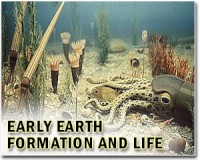 |
Leicester UK (SPX) Nov 30, 2010 The mystery of how an abundance of fossils have been marvellously preserved for nearly half a billion years in a remote region of Africa has been solved by a team of geologists from the University of Leicester's Department of Geology. They have established that an ancient wind brought life to the region - and was then instrumental in the preservation of the dead. Sarah Gabbott, Jan Zalasiewicz and colleagues investigated a site near the Table Mountains in South Africa. Their findings are published in the latest issue of the journal Geology. Sarah Gabbott said: "Near Table Mountain in South Africa lies one of the world's most mysterious rock layers. Just a few metres thick, and almost half a billion years old, it contains the petrified remains of bizarre early life-forms, complete with eyes and guts and muscles. "We investigated why these animals are so marvellously preserved, when most fossils are just fragments of bone and shell? The answer seems to lie in a bitter wind, blowing off a landscape left devastated by a massive ice-cap." Gabbott and Zalasiewicz added that microscopic analysis of the shale layers using a specially designed 'Petroscope', obtained with funding from the Royal Society, revealed remarkable and so far unique structures - myriads of silt grains, neatly wrapped in the remains of marine algae. The authors state: "The silt grains are sedimentary aliens - much bigger than the marine mud flakes in which they are embedded. They could only have been blown by fierce glacial winds on to the sea surface from that distant landscape. Arriving thick and fast, they carried nutrients into the surface waters, fuelling its prolific life. The deep waters, though, were overwhelmed by rotting, sinking vegetation, becoming stagnant and lifeless - ideal conditions to preserve the animal remains, down to their finest details. A cold wind, here, was key to both life and death." This study is published in: Gabbott, S.E., Zalasiewicz, J., Aldridge, R.J. and Theron, H. 2010. Geology 38, 1103-1106.
Share This Article With Planet Earth
Related Links University of Leicester Explore The Early Earth at TerraDaily.com
 After dinosaurs, mammals went supersized
After dinosaurs, mammals went supersizedAlbuquerque (UPI) Nov 26, 2010 When dinosaurs disappeared, the world's mammal species went on a growth binge and then hit an upper limit, all at about the same time, U.S. researchers say. Scientists at the University of New Mexico making a survey of big-mammal body size found mammal groups around the world tended to give rise to giant species at about the same time, ScienceNews.org reported Thursday. Such supe ... read more |
|
| The content herein, unless otherwise known to be public domain, are Copyright 1995-2010 - SpaceDaily. AFP and UPI Wire Stories are copyright Agence France-Presse and United Press International. ESA Portal Reports are copyright European Space Agency. All NASA sourced material is public domain. Additional copyrights may apply in whole or part to other bona fide parties. Advertising does not imply endorsement,agreement or approval of any opinions, statements or information provided by SpaceDaily on any Web page published or hosted by SpaceDaily. Privacy Statement |